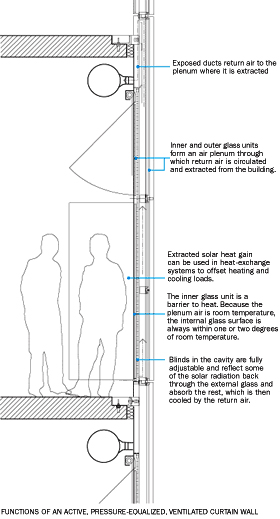Innovation: Features
Seeking Innovative Alternatives
Kieran Timberlake Associates pumps research into architecture.




In 2001 the American Institute of Architects (AIA) College of Fellows awarded its first Latrobe Fellowship to Philadelphia architects Stephen Kieran, FAIA, and James Timberlake, FAIA. The grant was established to fund research leading to significant advances in the profession of architecture. Since receiving the award, KieranTimberlake Associates (KTA) has been immersed in the study of building processes, assemblies, products, and new materials. The firm's research is leading to commercial applications, including advanced building-envelope composites, modular bathroom units, and factory-built door assemblies.
This research plays a major role in all of KTA's new projects, which is evident in the Melvin J. and Claire Levine Hall at the University of Pennsylvania's School of Engineering and Applied Science. The 48,000-square-foot facility houses offices, laboratories, meeting spaces, and a 150-seat auditorium. Levine Hall is shoehorned into a thicket of older brick and stone classroom buildings and connected to existing buildings on the north and south. The footprint and massing are calibrated to agree with the fenestration, scale, and parapet height of the adjacent buildings. A newly landscaped pedestrian walk leads to the double-height lobby on the eastern facade, with a view through to a courtyard in the rear.
The construction method can be described as a hybrid of sorts. The interiors were conceived as loft spaces with 14-foot ceilings. To achieve this, the architects designed a post-tensioned concrete structure, which allows a substantial reduction in the horizontal depth, thereby providing more usable volume within the building. The building envelope, on the other hand, bears the fruit of KTA's research into alternative construction processes. Instead of the typical stick-built curtain wall, the architects chose an active, ventilated unitized system. It's a double-facade composed of large, unitized aluminum frames, which were fabricated and glazed in a factory and shipped to the site for installation.
This system, while more common in Europe, has not been employed much in the U.S. While more complicated to plan, the final product has tighter tolerances and a refinement that is striking. Furthermore, because of the efficiency provided by the double facade, the glazing requires no tinting or reflective coatings. Thus, the building is exquisitely transparent in the day and sparkles when lit from within at night. KTA overcame the cramped circumstances of the site and created for Levine Hall a prominence that a sophisticated 21st century research center deserves.


